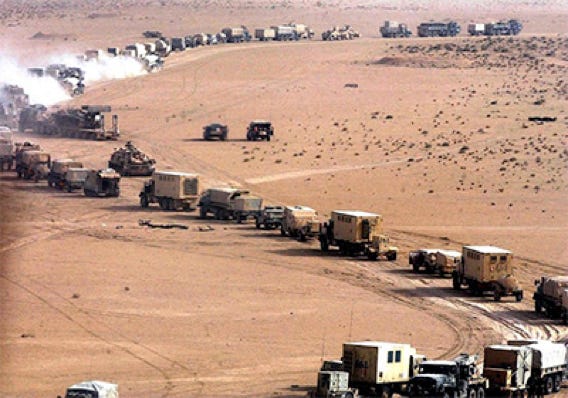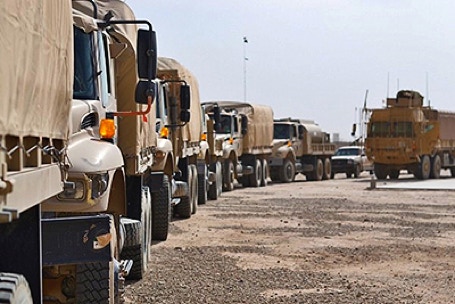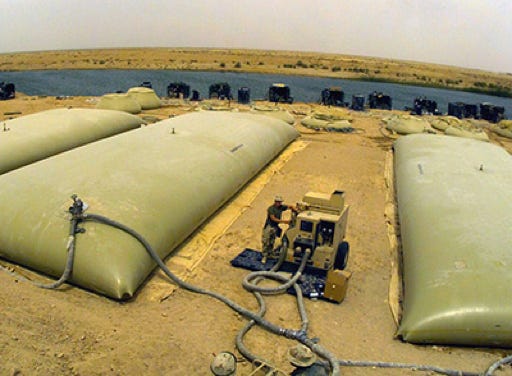Talking Proud: Service & Sacrifice
Logistics in the Iraq War: “A Herculean feat”
“Good generals study tactics. Great generals study logistics”
Final thoughts
I worked for a USAF general once who told us, angrily,
“The next officer coming in here with a bright idea had better bring in the wire to set up the needed communications.”
The most glaring problem encountered at the outset of OIF was the forces' lack of truck capacity. For example, the 377th Theater Sustainment Company (TSC) required 930 medium trucks but had only 298 on hand. Furthermore, contractor truck support was inadequate. The Corps Support Command said it had only 20 percent of its truck requirement when combat operations kicked off. This made life rough. Remember, it was well over 300 miles from launch points to Baghdad.
A decision was made to use bottled water instead of relying on bulk water production. That caused a significant increase in truck demand, not to mention the breakage experienced along the way.
In addition to the bottled water, the "Water Dogs" of the 226th Quartermaster Water Purification Co. began pumping nearly 6,000 gallons per day of potable water from three "reverse osmosis" purification pumps. They started providing water to combat forces coming through on their way north. This example shows a Marine Corps reverse-osmosis water purification system in Iraq, drawing water from a nearby river.
Anthony Cordesman, whom I mentioned earlier, noted a most revealing point regarding the rapidly changing situation on the battlefield. He wrote that the logistics units often did not know what was going on operationally; they lacked “situational awareness.” The logistics units could easily find themselves in a situation where they were not exactly sure where the maneuver unit was that they needed to support. In addition, the dynamics of the battlefield required units to move to locations that were not in the plan, which demanded trucks to move them to such locations, and as I have mentioned, trucks were in short supply. Furthermore, the truck transportation units needed the capacity to defend themselves but were not adequately organized or equipped to do that.
Brigadier General Jack Stultz, commander of the 143d Transportation Command (Forward), commented on this issue of situational awareness for the logistics people:
"It was not so much being able to supply them, but to locate where they were moving to. That tended to be a challenge for us as we moved our convoys across the desert.”
Let me use this moment to discuss the Main Supply Routes (MSRs). MSRs were planned based on photo reconnaissance. However, the roads did not turn out to be what the photo interpreters thought they saw in the photos. The edges of the roads were falling apart, making two-lane roads one-lane. The troops also encountered more dirt roads than expected. Many of the shoulders of the roads could not handle the weight of force movements. And then battlefield problems, such as those encountered at As Samawah, forced units to use alternate routes that were not paved. So overall, movement slowed.
I wish to return to General Wallace momentarily and acknowledge tension between him and Secretary of Defense Donald Rumsfeld, and even between him and General Tommy Franks, the CENTCOM commander and Wallace’s boss.
The tension revolved fundamentally around the size of the force employed in this invasion. This question was hotly debated throughout the mission planning before the invasion.
Wallace felt he did not have enough. Major news outlets in the US quoted him as saying, “The enemy we're fighting against is different from the one we'd war-gamed against.” His superiors rebuked him for this.
Others also criticized Wallace’s force for getting bogged down in fighting an enemy more resilient than thought; to put it bluntly, the overall force was too small.
Rumsfeld worked hard to keep the force levels down during the planning stages and took public issue with Wallace, as did his chairman, Joint Chiefs of Staff (CJCS) General Richard Myers, USAF. General Franks reportedly chewed out Wallace for his remarks, but Wallace was not alone.
PBS Frontline interviewed General Wallace after he left Iraq in June 2003. I commend this interview to you because it is most illuminating.
I have not found evidence that Wallace was fired, but the invasion began in March 2003, and he left in June 2003, replaced by Franks. Franks set up a new headquarters led by newly promoted Lt. General Ricardo Sanchez, over the objections of the vice chief of staff, Army, General Jack Keane. That said, Wallace did receive his fourth star.
General Barry McCaffrey, USA, commanded the 24th ID in the first Iraq invasion, Operation Desert Storm. He would later rise to four stars and command the US Southern Command before his retirement. He was an outspoken man who spoke up loudly about a number of issues. The one that caught my attention was McCaffrey's statement that the coalition forces lacked troops to guard the 300-mile supply line.
Speaking broadly, food, water, and ammunition were the priorities. The general experience was that everything I’ve touched on thus far resulted in replenishment of food and water coming three days late. Supply units pushed as hard as they could to make this up, but remember that these units, too, were exposed to battlefield demands and firefights.
I'll stop here.
I said I wanted to focus on the enormity of the logistics challenges associated with this type of "need for speed" invasion. Frankly, it is hard to imagine how everything was synchronized as well as it was, especially given rapidly changing requirements and the fact that combat began before the logistics base was fully set. The hard work put in logistically paid huge dividends after Baghdad fell.
Retired Col. Gregory Fontenot, USA, wrote:
"An armored move of this scale and scope placed an almost overwhelming logistics burden on theater and corps logistics units supporting V Corps and the MEF … Truckers and logistics soldiers drove themselves to the point of exhaustion. They kept on driving and fighting to get supplies forward. For the American logistics and combat troops alike, there was no time-out. From their perspective, the pace slowed from outrageous to merely brutal … Logistically, OIF tested the Army. The size of the theater, tempo of operations, complexity, distribution of forces, nature of the threat, terrain, strategic constraints, paucity of logistics forces, and requirements to support other services proved daunting. Despite these difficulties, Army (logistics) troops turned in a heroic performance by providing 'just enough' to sustain the fight.
"There are some good news logistics stories. Under incredibly difficult conditions, logistics troops made sure that food, fuel, and ammunition got forward. Logistics troops and their leaders literally fought their way forward to get the vital supplies in the hands of the combat soldiers. The scope and scale of their effort are hard to grasp, but it was truly monumental. Joint logistics functioned across 8,000 miles and met the theater’s needs without a long buildup of stocks. As one logistician put it, there were still some 'iron hills,' but there were no 'iron mountains.'
"General Dave McKiernan offered the best testimony to the logistics troops when he noted on 1 May 2003, 'the truth of the matter is we did not stop operational tempo because of any class of supply, and what was accomplished was never impeded by logistics, and I think that is a remarkable story.'"
Someone else called it "Herculean." I agree.
Click to zoom graphic-photo




